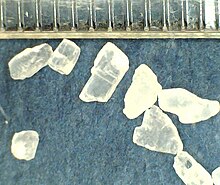This article needs additional citations for verification. (June 2023) |





A USB microscope is a low-powered digital microscope which connects to a computer's USB port. Microscopes essentially the same as USB models are also available with other interfaces either in addition to or instead of USB, such as via WiFi. They are widely available at low cost for use at home or in commerce. Their cost varies in the range of tens to thousands of dollars. In essence, a USB microscope is a webcam with a high-powered macro lens, and generally uses reflected rather than transmitted light, using built-in LED light sources surrounding the lens. The camera is usually sensitive enough not to need additional illumination beyond normal ambient lighting. The camera attaches directly to the USB port of a computer without the need for an eyepiece, and the images are shown directly on the computer's display.
They usually provide modest magnifications (about 1× to 200×) without the need to use eyepieces, at cost very much lower than conventional stereomicroscopes.[1] The quality of the final image depends on the lens and sensor quality, resolution—which may range from 1.3 megapixels to 5 MP or more—operator skill, and illumination quality. Both still images and videos can be recorded on most systems.
- ^ "Introduction to Stereomicroscopy" by Paul E. Nothnagle, William Chambers, and Michael W. Davidson, Nikon MicroscopyU.
© MMXXIII Rich X Search. We shall prevail. All rights reserved. Rich X Search
